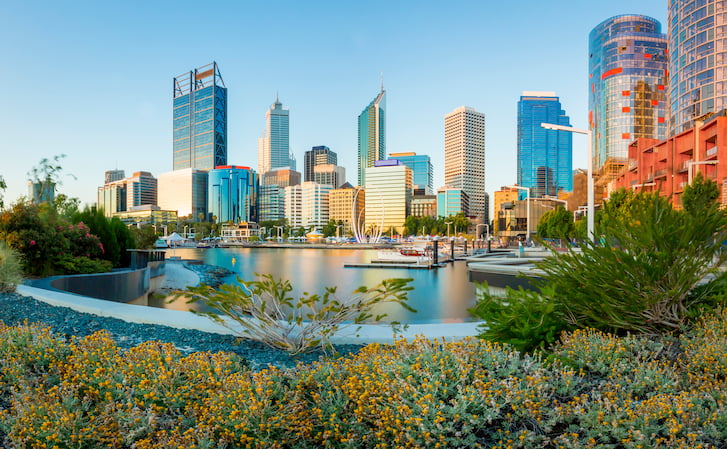No other single market offers more growth opportunities for business than India, the Indian Business Forum held in Perth was told on Friday.
Author of the Federal Government’s India Economic Strategy to 2035 Peter Varghese told more than 200 dignitaries and business people that WA businesses should do their due diligence to reap the benefits of emerging opportunities in the fastest growing large economy.
The forum, organised by the Department of Jobs, Tourism, Science and Innovations (JTSI) in collaboration with the Australia India Business Council and supported by the Indian Consulate and CCIWA, is part of the Asian Business Series of roundtables.
According to the International Monetary Fund, India’s growth is expected to be 7.3 per cent this year, due to its ‘more expansionary policy stance’. Its population is more than 1.3 billion.
Bilateral trade between WA and India was $3.8 billion last year, making it WA’s 10th largest partner and sixth largest export market worth $3.4 billion. Nationwide, India accounts for more than $25 billion in bilateral trade and is Australia’s fifth largest export market.
Varghese pinpointed 10 sectors in his report, with education the flagship. He urged providers to look closely at the nation that ‘wants to upskill 400 million people’.
“They are not going to be able to do it by constructing bricks and mortar education institutions. So there will be a strong interest in studying abroad and also in the digital delivery of education and that means a focus on content, which is where I think Australia can help,” he said from the sidelines of the forum.
Australia was already one of the world leaders in education and India the second largest source of international students to Australia, he said, with the education and training requirements of India weaving their way through virtually every sector.
Varghese identified resources, agribusiness and tourism as lead sectors in the report behind education, with a further six – energy, health, financial services, infrastructure, sport and science and innovation – as also having potential. Ten key states were identified rather than viewing India as one huge market.
“If you can break it down into realistic bite-sized pieces then you can begin to think more strategically about India,” he said.
There is potential to triple Australia’s exports and increase investment 10-fold, Varghese, a former Foreign Affairs and Trade Department secretary, said
“We are starting off on a low base but there is more growth tissue in this economic relationship than any other single market. That is why we can lift our export performance from $15b to $45b at a national level and we can lift our outward investment level by an even larger measure from $10b to $100b,” he said.
Don’t be ‘once bitten, twice shy’
While building business ties won’t all be smooth sailing and requires patience, Varghese said the corporate perceptions of India and its market opportunities were out of date and sheer scale of growth warranted another look by businesses who had been bitten before.
“There is an understanding of India as a back office and not, for example, as a research and development centre,” he said.
“This is now the third largest economy, the fastest growing large economy. It is embarked on a program of economic reform which will translate into improvements in the ease of doing business.
“There is a focus on foreign investment and then you have the structural reasons for looking more closely at the Indian market which is the complementarity of the two economies.”
Varghese says looking to India would spread the risk, not only for corporate Australia but also for national resilience, because ‘you don’t want to have too many eggs in too few baskets’.
Reciprocal strategy
Government of India Ambassador Anil Wadhwa, who is writing the Australia Economic Strategy for the Indian Government to be released later in the year, said WA had a natural advantage over other states because of its endowment of resources and minerals with demand for LNG and battery minerals including lithium, cobalt, nickel, vanadium and rare earths set to increase.
He said the Indian Government was focused on a major shift in electric vehicle production by 2030, which would be driven by availability of battery raw materials, of which WA is rich in.
Wadhwa said one of the recommendations he intended to make would be around attracting Australian businesses to manufacture in India. He said machinery and medical equipment were two areas with potential.
Direct flights a must
Wadhwa said the limited number of flights to Australia was holding business ties back and business people were ‘always complaining’ to him about having to take several flights to do business.
“In my view without that connectivity half the efforts are in vain, it’s an extremely important issue and should be paid attention to by both countries,” he said.
Varghese agreed, flagging it as the single most important thing to do to get the economic relationship moving more quickly.
“Connectivity is a huge advantage and you contrast one carrier flying directly between Australia and India with the huge number of daily flights we have to China, or parts of Australia, you really do need to build up critical mass and direct airflights are a key part of that,” he said.
Tourism Minister Paul Papalia, the Indian Government and airlines representatives met several times late last year to discuss the case for direct flights between Perth and India.
“We are continuing to look at opportunities for a direct air service between India and Perth, in fact I returned to India in March to further progress discussions with several airlines,” Papalia told BP Digital today.
“In the meantime, Tourism WA has appointed dedicated marketing representative in Mumbai and committed marketing funds to help raise awareness of Perth and Western Australia as a destination in India.”
Not growing fast enough
High Commissioner of India to Australia Dr Ajay Gondane said India felt its growth rate of between 6-7.5 per cent was far below its double-digit expectations and the government knew it needed to be accelerated, with education and improving its ease of doing business rating as keys to achieving its aspirations.
“We abolished 1300 laws in the last five years. Our ease of doing business was 145 and now it’s 135 because we have recognised the challenges and decided to meet those challenges,” he said.
He urged businesses to engage now because ‘Indian aspirations are not going to wait for you’.
CCIWA’s International Trade and Investment Centre Manager Mike Carter said there had never been a better time to look at India as a potential business partner and WA needed to be part of the growing convergence of trade, investment and education engagement between the two countries.
Read the India Economic Strategy to 2035 here. Find out more about the State Government’s Asian engagement at the JTSI website.
► CCIWA’s International Trade and Investment Centre helps WA businesses grow import and export opportunities, better understand capital-sourcing options and become investment-ready. Visit here for more information.












